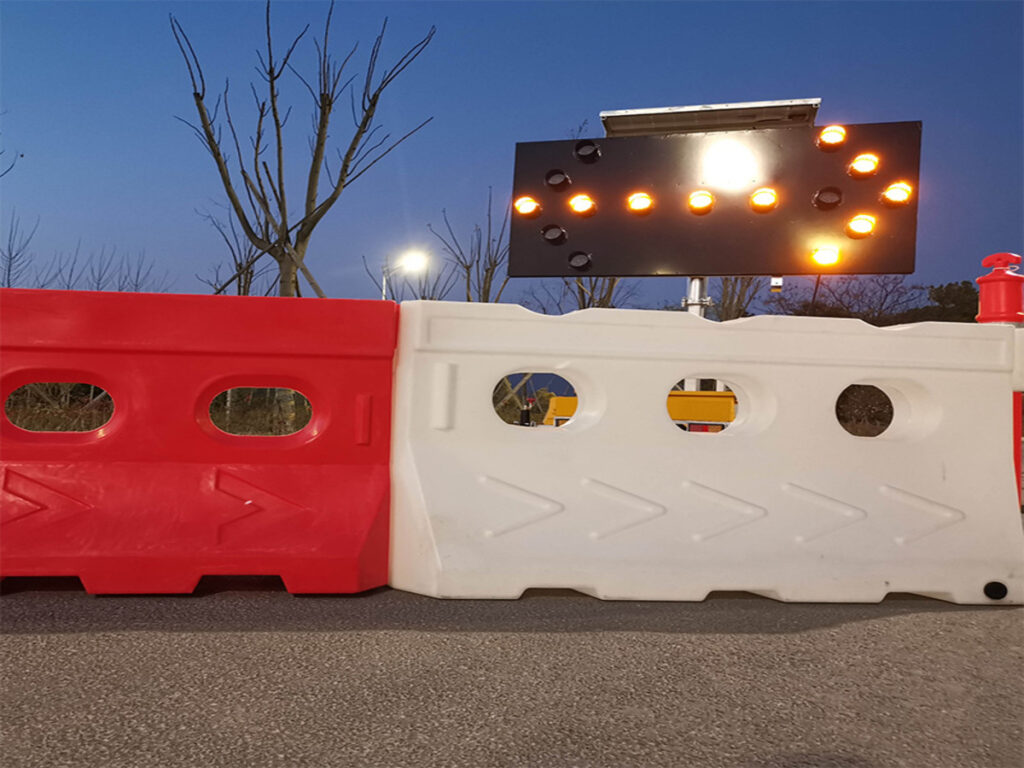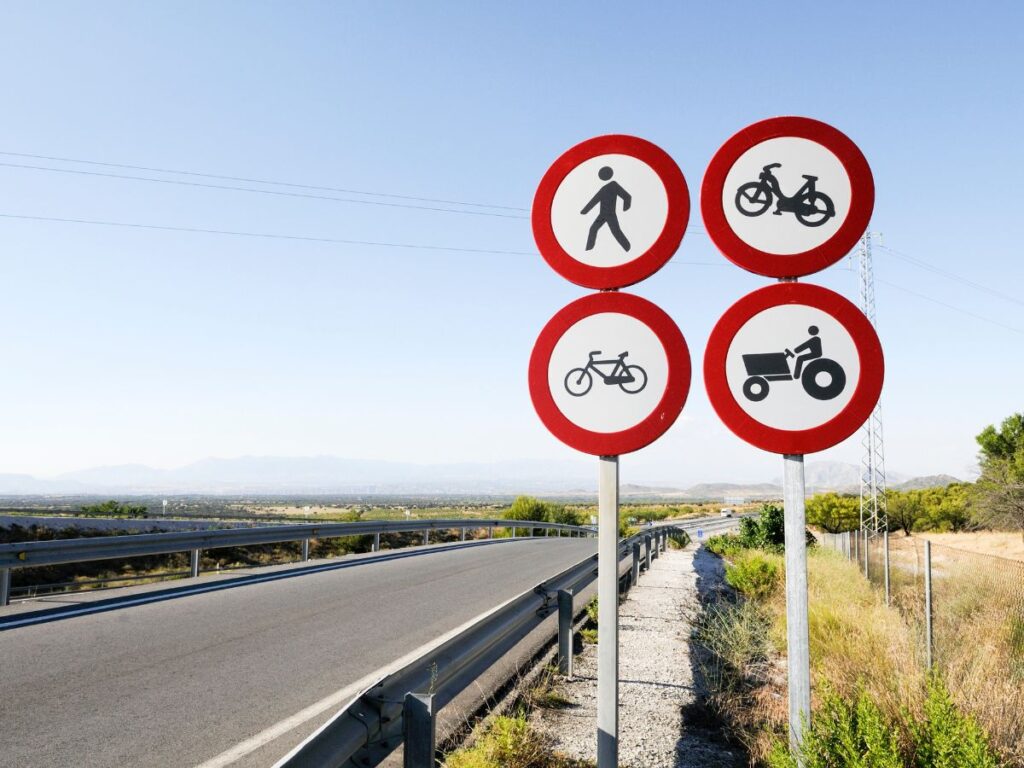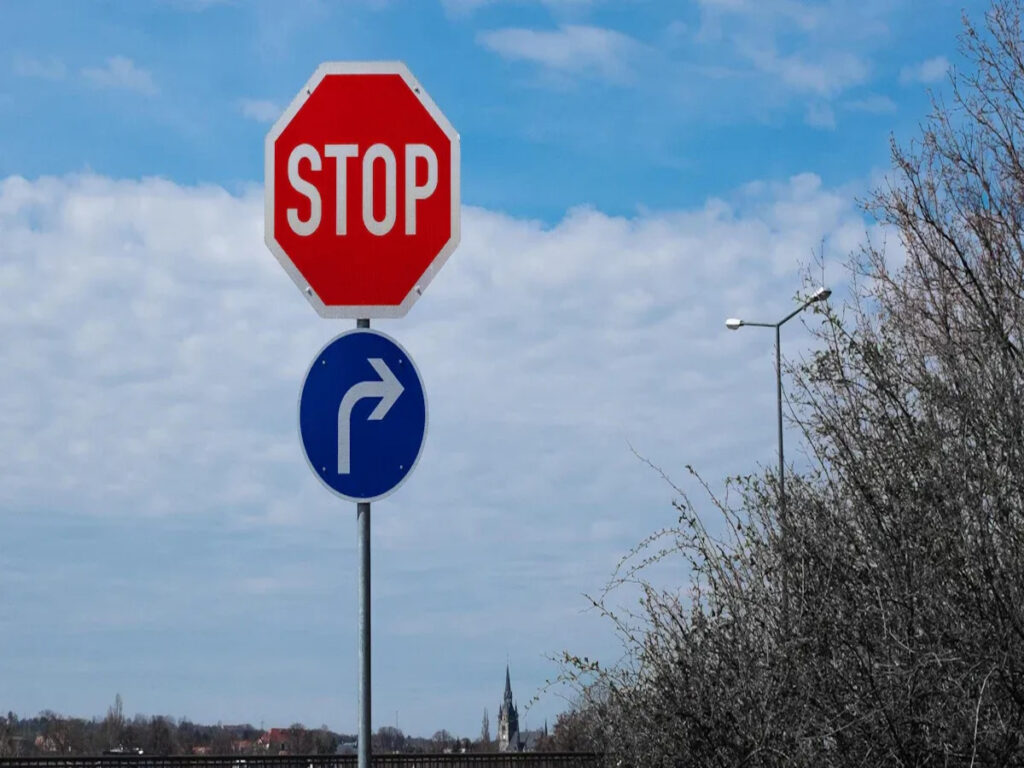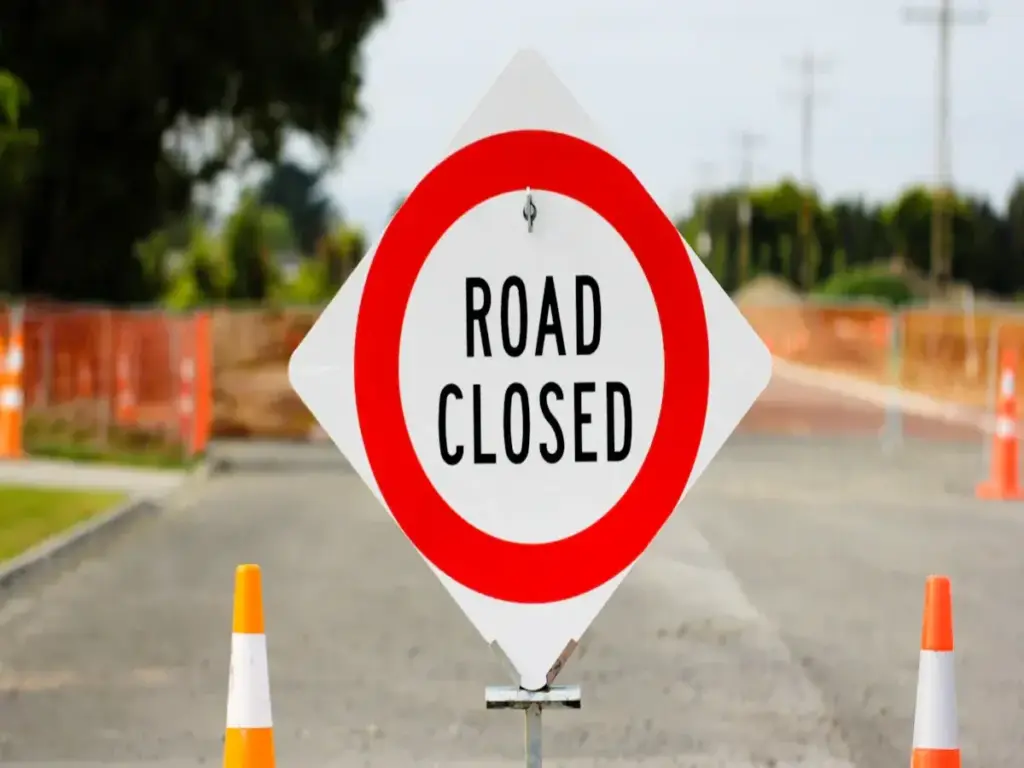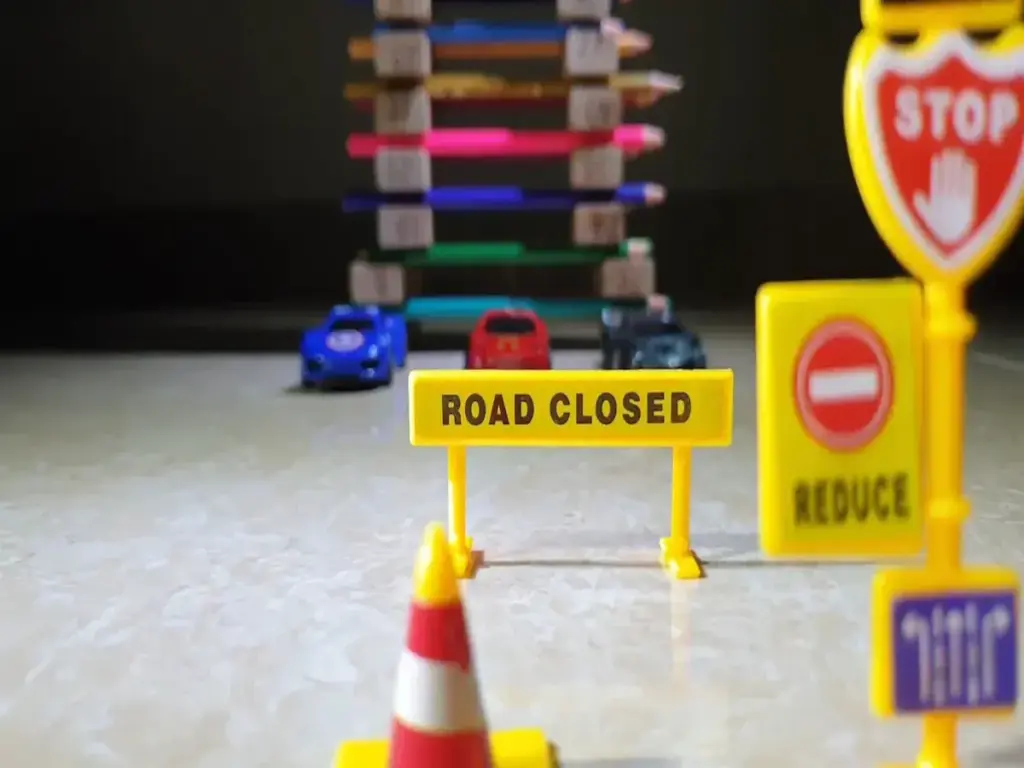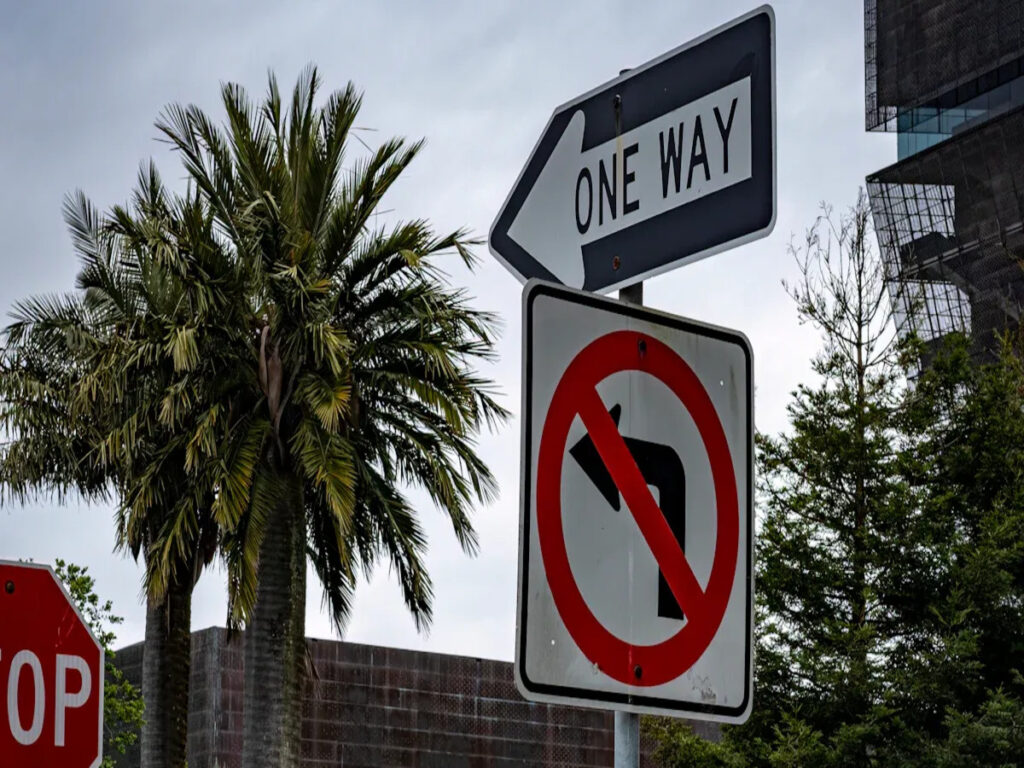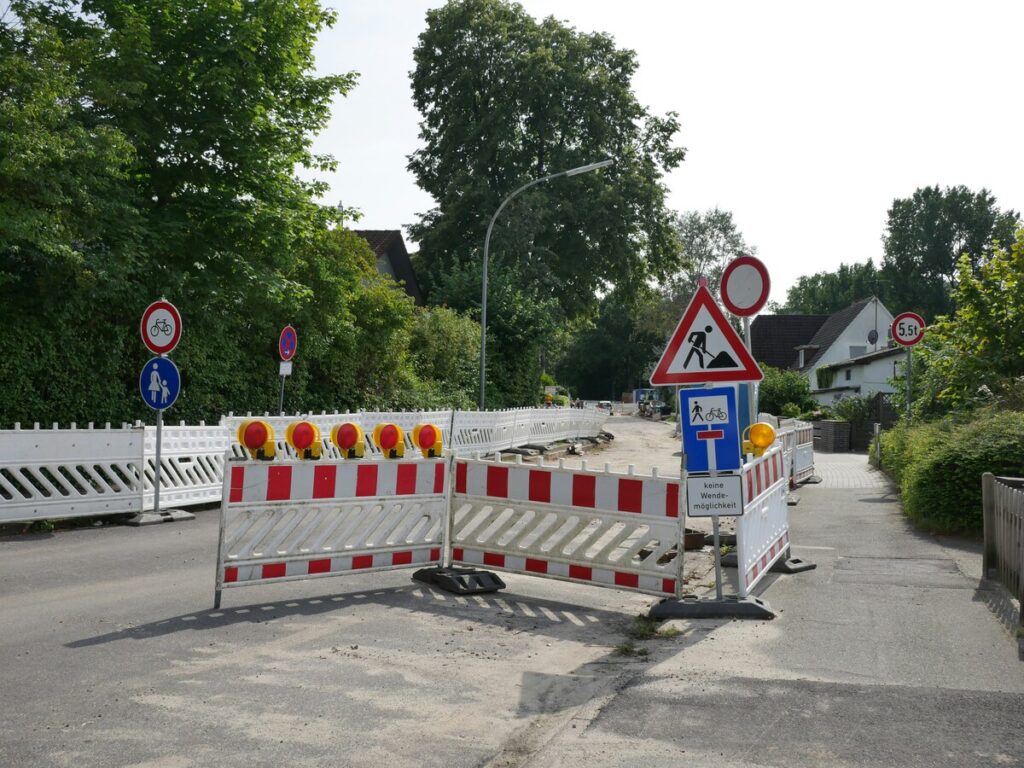
व्यस्त सड़क पर सुरक्षा अवरोधों और सुरक्षा बैरिकेड्स को मिलाने से गंभीर परिणाम हो सकते हैं. अवरोधों का गलत उपयोग श्रमिकों को जोखिम में डाल सकता है, सुरक्षा नियमों का उल्लंघन करें, और परिणामस्वरूप महंगे कानूनी मुद्दे सामने आते हैं. दुर्घटनाओं को रोकने और दुर्घटनाओं में क्षति को कम करके श्रमिकों और ड्राइवरों की सुरक्षा के लिए सुरक्षा बाधाएँ महत्वपूर्ण हैं. ये बाधाएं, MASH-प्रमाणित मॉडल की तरह, सुरक्षा के लिए कड़ाई से परीक्षण किया जाता है. सही बाधाओं का उपयोग यह सुनिश्चित करता है कि परियोजनाएँ निर्धारित समय पर बनी रहें, कानूनी परेशानी से बचें, और उच्च सुरक्षा मानक बनाए रखें.
Optraffic की एक विस्तृत श्रृंखला प्रदान करता है सुरक्षा बाधाएँ जो उच्चतम उद्योग मानकों को पूरा करते हैं. हमारे उत्पाद अधिकतम सुरक्षा प्रदान करने और सुरक्षा नियमों का अनुपालन सुनिश्चित करने के लिए डिज़ाइन किए गए हैं, अपने कार्यस्थल को सुरक्षित और संरक्षित रखना. विश्वसनीय सुरक्षा बाधाओं के हमारे चयन का आज ही अन्वेषण करें.
चाबी छीनना
- सुरक्षा अवरोधक कारों को खतरनाक स्थानों से दूर रखते हैं. वे व्यस्त या लंबी नौकरियों पर श्रमिकों और ड्राइवरों की सुरक्षा करते हैं.
- सुरक्षा बैरिकेड लोगों और कारों को चेतावनी देने और उनका मार्गदर्शन करने में मदद करते हैं. वे छोटी नौकरियों के लिए अच्छे हैं, इवेंट्स, या स्थान जो अक्सर बदलते रहते हैं.
- बाधाएं मजबूत और भारी हैं. इन्हें स्थापित करने के लिए मशीनों की आवश्यकता होती है. बैरिकेड हल्के और हटाने में आसान हैं. आप उन्हें हाथ से सेट कर सकते हैं.
- सही सुरक्षा उपकरण चुनने से सड़कें और साइटें सुरक्षित हो जाती हैं. यह कानून का पालन करने में मदद करता है और दुर्घटनाओं और देरी को रोकता है.
- हमेशा स्थानीय सुरक्षा नियमों को देखें. विश्वसनीय आपूर्तिकर्ता चुनें ताकि बैरियर और बैरिकेड सही मानकों को पूरा करें.
बाधाएं और बैरिकेड क्या हैं??
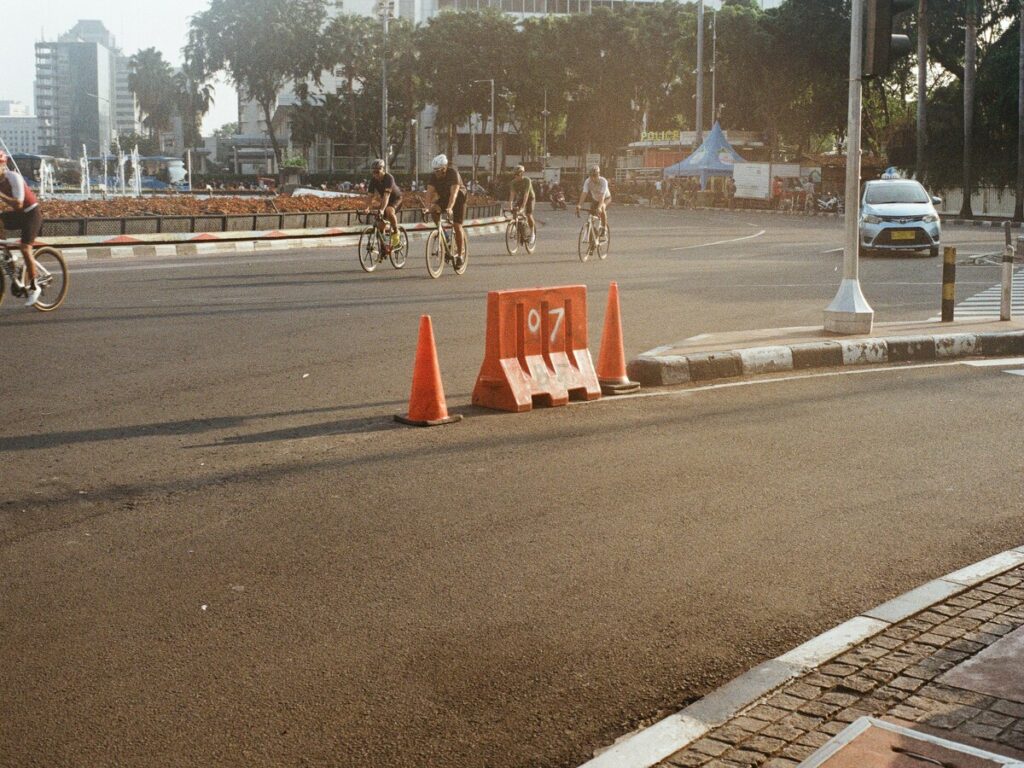
परिभाषाएं
सड़कों और निर्माण स्थलों पर लोगों को सुरक्षित रखने के लिए बैरियर और बैरिकेड दोनों का उपयोग किया जाता है, लेकिन वे वही काम नहीं करते.
- बैरियर एक उपकरण है जो एक मजबूत ब्लॉक बनाता है. यह सड़क से बाहर जाने वाली कारों को रोक या हटा सकता है. विभिन्न प्रकार की बाधाएँ हैं, सड़क के किनारे वाले लोगों की तरह, बीच में, पक्ष में, या जिन्हें आप स्थानांतरित कर सकते हैं.
- बैरिकेड एक ऐसा उपकरण है जो स्पष्ट चेतावनी देता है. यह ड्राइवरों को बताता है कि ख़तरा कहाँ है या किस रास्ते से जाना है. बैरिकेड्स कारों को आगे बढ़ने से नहीं रोक सकते. वे ट्रैफ़िक को यह दिखाने में मदद करते हैं कि कहाँ जाना है और जोखिम भरे स्थानों को चिह्नित करके श्रमिकों को सुरक्षित रखते हैं.
ये अर्थ AASHTO और जैसे समूहों से आते हैं समान यातायात नियंत्रण उपकरणों पर मैनुअल. यह सुनिश्चित करने के लिए कि वे लोगों और चीज़ों को सुरक्षित रखें, बैरियर्स को कठिन क्रैश टेस्ट से गुजरना पड़ता है.
यातायात सुरक्षा में महत्व
बाधाएं और अवरोधक सड़कों और निर्माण स्थलों पर दुर्घटनाओं और चोटों को रोकने में मदद करते हैं. बैरियर कारों को खतरनाक जगहों पर जाने से रोककर पैदल चलने वाले श्रमिकों और लोगों को सुरक्षित रखते हैं. वे रास्ते में आने वाली चीज़ों की सुरक्षा भी करते हैं और ट्रैफ़िक को विभाजित भी करते हैं. ड्राइवरों को परिवर्तन या खतरों के बारे में चेतावनी देने के लिए बैरिकेड्स चमकीले रंगों और चमकदार हिस्सों का उपयोग करते हैं. वे कार्य क्षेत्रों में कारों को सुरक्षित रूप से ले जाने में मदद करते हैं और लोगों को नुकसान से दूर रखते हैं.
| भूमिका | विवरण |
|---|---|
| बाधाओं | कारों को रोकने या स्थानांतरित करने के लिए एक मजबूत ब्लॉक बनाएं, दुर्घटनाओं को रोकना. |
| बाड़ | स्पष्ट संकेत दें, ड्राइवरों को चेतावनी देना और सुरक्षित रास्ते दिखाना. |
| कार्य क्षेत्र | जोखिम भरे स्थानों पर यातायात कम करें और श्रमिकों और लोगों को सुरक्षित रखें. |
| मानकों | दुर्घटनाओं में सुरक्षित रहने और बैरियर और बैरिकेड दोनों के लिए अच्छी तरह से काम करने की आवश्यकता है. |
जब इन उपकरणों का सही तरीके से उपयोग किया जाता है तो सड़क सुरक्षा बेहतर हो जाती है. वे यह नियंत्रित करने में मदद करते हैं कि कारें कैसे चलती हैं, ट्रैफिक जाम रोकें, और सभी के लिए स्थानों को सुरक्षित बनाएं.
सामान्य भ्रम
बहुत से लोग बाधाओं और अवरोधकों को मिला देते हैं क्योंकि ये दोनों सड़कों और निर्माण स्थलों पर दिखाई देते हैं. सबसे बड़ा अंतर यह है कि वे क्या करते हैं. बैरियर कारों को रोक या आगे बढ़ा सकते हैं, लेकिन बैरिकेड केवल चेतावनी देते हैं या मार्गदर्शन करते हैं. गलत का प्रयोग खतरे का कारण बन सकता है और कानून तोड़ सकता है. बिल्डरों और सड़क श्रमिकों को पता होना चाहिए कि सभी को सुरक्षित रखने और नियमों का पालन करने के लिए किस उपकरण का उपयोग करना है.
बाधाओं
सड़क सुरक्षा बाधाएँ क्या हैं??
लोगों को सुरक्षित रखने के लिए सड़क सुरक्षा अवरोध बहुत महत्वपूर्ण हैं. ये अवरोध कारों के बीच एक मजबूत दीवार बनाते हैं, कार्यकर्ता, और लोग चलते हैं. सुरक्षा अवरोधक कारों को खतरनाक स्थानों में जाने से रोकते हैं. वे कार्य क्षेत्रों में कारों को सुरक्षित रूप से ले जाने में मदद करते हैं. यदि कोई दुर्घटना होती है तो बाधाएं बल ले लेती हैं. इससे लोगों को गंभीर चोट लगने से बचाने में मदद मिलती है. सुरक्षा बाधाएँ श्रमिकों और सड़क उपयोगकर्ताओं को यह दिखाकर भी सुरक्षित रखती हैं कि यह कहाँ सुरक्षित है. वे खतरों को लोगों से दूर रखते हैं. क्रैश रेटेड बाधाओं को यह सुनिश्चित करने के लिए कठिन परीक्षणों से गुजरना होगा कि वे वास्तविक जीवन में अच्छा काम करते हैं.
सुरक्षा अवरोधक कारों को रोकने से कहीं अधिक कार्य करते हैं. वे यह नियंत्रित करने में मदद करते हैं कि कारें कैसे चलती हैं, सड़क पर चीजों की रक्षा करें, और दिखाएँ कि कोई स्थान कानून का पालन करता है.
बाधाओं के प्रकार
सड़क पर कई प्रकार की बाधाएँ हैं. प्रत्येक प्रकार के अपने अच्छे अंक होते हैं. सबसे आम प्रकार हैं:
| बाधा प्रकार | सामग्री | प्रमुख विशेषताऐं | विशिष्ट उपयोग |
|---|---|---|---|
| कंक्रीट बाधाएँ | ठोस | भारी, मज़बूत, एक लंबे समय तक | राजमार्ग, व्यस्त सड़कें |
| इस्पात की बाधाएँ | इस्पात | आसानी से झुकें, जंग मत लगाओ, स्थानांतरित करना आसान है | सड़कें, कार्य स्थल |
| प्लास्टिक पानी से भरी बाधाएँ | प्लास्टिक (एचडीपीई), पानी/रेत | खाली होने पर प्रकाश करें, देखने में आसान है, स्थापित करने के लिए सरल | भवन क्षेत्र, इवेंट्स |
| अस्थायी इस्पात बाधाएँ | इस्पात | स्थानांतरित करना आसान है, शीघ्रता से स्थापित करना | छोटी सड़क वाली नौकरियाँ |
| ठोस सुरक्षा बाधाएँ | ठोस, इस्पात, प्लास्टिक | कठिन, दुर्घटनाओं को रोकें, क्रैश रेटेड | लंबे या छोटे उपयोग के लिए |
| साइट बाधाएँ | धातु, प्लास्टिक | बदला जा सकता है, सुरक्षित क्षेत्र दिखाएं | निर्माण स्थल |
प्रत्येक बाधा प्रकार किसी भिन्न कार्य के लिए उपयोग किया जाता है. कंक्रीट या स्टील जैसी मजबूत बाधाएं लंबी नौकरियों के लिए सर्वोत्तम हैं. पानी से भरी बाधाएं छोटे बदलावों के लिए अच्छी होती हैं.
प्रमुख विशेषताऐं
सुरक्षा अवरोध अन्य सड़क उपकरणों से भिन्न हैं क्योंकि वे वास्तविक सुरक्षा देते हैं. शंकु या संकेत कारों को नहीं रोक सकते, लेकिन ठोस बाधाएँ हो सकती हैं. अधिकांश अवरोध कंक्रीट जैसी मजबूत चीज़ों से बने होते हैं, इस्पात, या कठोर प्लास्टिक. कई बैरियरों पर चमकदार पट्टियाँ होती हैं ताकि ड्राइवर उन्हें बेहतर ढंग से देख सकें. लोगों को सुरक्षित रखने के लिए क्रैश रेटेड बाधाओं को सख्त नियमों का पालन करना होगा. कुछ बाधाएँ, जैसे यातायात बाधाएँ और सुरक्षा बाधा प्रणालियाँ, कारों को नियंत्रित करने और ट्रैफिक जाम रोकने में मदद करें. ठोस बाधाएँ लम्बे समय तक या थोड़े समय तक ही रह सकती हैं, नौकरी के आधार पर. वे लोगों को रखते हैं, चीज़ें, और कारों को सही जगह पर और खतरे से दूर रखकर प्रकृति को सुरक्षित रखें.
सुरक्षा बैरिकेड्स
सुरक्षा बैरिकेड क्या हैं??
लोगों को सुरक्षित रखने के लिए सुरक्षा बैरिकेड्स बहुत महत्वपूर्ण हैं. They are used in building areas and at big events. These barricades are not permanent. They help guide cars and people and keep workers safe from danger. They also stop people from going into risky places. On building sites, safety barricades show where dangers are. वे यह नियंत्रित करने में मदद करते हैं कि कारें कैसे चलती हैं. They help in emergencies too. घटनाओं पर, organisers use barricades to manage crowds. Barricades make safe paths for people to walk. They also help keep areas safe by marking them clearly. Barricades can be moved or changed when needed. Their main job is to stop accidents and keep things in order.
Safety barricades are easy to move. This helps when sites change quickly or need new paths.
बैरिकेड्स के प्रकार
There are many kinds of safety barricades. प्रत्येक प्रकार एक विशेष कार्य के लिए बनाया गया है. सबसे आम प्रकार हैं:
- टाइप I, द्वितीय, और III ट्रैफिक बैरिकेड्स: These come in different sizes and strengths. टाइप I धीमी सड़कों के लिए अच्छा है. टाइप III व्यस्त सड़कों और राजमार्गों के लिए सर्वोत्तम है.
- पोर्टेबल बैरिकेड्स: ये हल्के और चलने में आसान हैं. वे आयोजनों के लिए अच्छे हैं, छोटी नौकरियाँ, या आपात स्थिति.
- बैरिकेड टेप और शंकु: इनका प्रयोग छोटे-मोटे खतरों के लिए किया जाता है. वे लोगों को सुरक्षित स्थानों पर मार्गदर्शन करने में मदद करते हैं.
- बैरिकेड द्वार: ये नियंत्रित करते हैं कि कौन निश्चित क्षेत्रों में जा सकता है. इनका उपयोग आयोजनों में भीड़ को नियंत्रित करने के लिए किया जाता है.
ब्रिटेन में, कंक्रीट स्टेप बैरियर अक्सर मोटरमार्गों पर देखे जाते हैं. इनका उपयोग सड़क के बीच में किया जाता है. ये बैरियर बहुत मजबूत हैं और सख्त सुरक्षा नियमों का पालन करते हैं.
प्रमुख विशेषताऐं
अच्छे सुरक्षा बैरिकेड सख्त और मजबूत होने चाहिए. उन्हें खराब मौसम में टिके रहने की जरूरत है. कारों या मशीनों से टकराने पर उन्हें टूटना नहीं चाहिए. बैरिकेड्स को देखना आसान होना चाहिए. निर्माता चमकीले रंगों और चमकदार भागों का उपयोग करते हैं. कभी-कभी वे रोशनी जोड़ते हैं ताकि लोग उन्हें रात में देख सकें. बैरिकेड्स को लगाना और हटाना आसान होना चाहिए. यह तब महत्वपूर्ण है जब चीजें तेजी से बदलती हैं या आपात्कालीन स्थिति में होती हैं. सुरक्षा बैरिकेड्स को MUTCD जैसे नियमों और स्थानीय कानूनों का पालन करना चाहिए. कुछ बैरिकेड्स को छोटी या विषम जगहों पर फिट करने के लिए बदला जा सकता है. मजबूत बैरिकेड्स कार्यकर्ताओं और लोगों को सुरक्षित रखते हैं. वे दिखाते हैं कि खतरा कहाँ है और कारों को सुरक्षित रूप से चलने में मदद करते हैं. व्यस्त स्थानों में, मजबूत बैरिकेड्स दुर्घटनाओं को रोकने और चीजों को अच्छी तरह से चलाने में मदद करते हैं.
अपनी आवश्यकताओं के लिए सही बैरिकेड्स चुनने के बारे में अधिक विस्तृत जानकारी के लिए, हमारे ब्लॉग की जाँच करें, बिक्री के लिए ट्रैफ़िक बैरिकेड्स के बारे में आपको सब कुछ जानने की जरूरत है.
प्रमुख अंतर
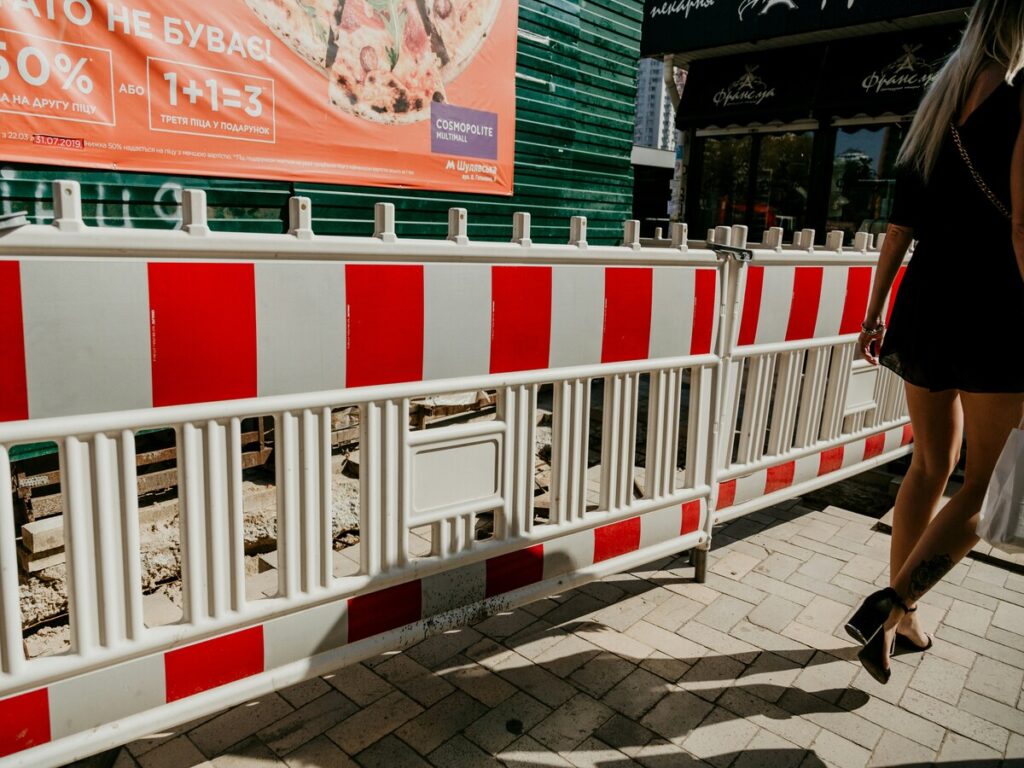
कार्य एवं उपयोग
बैरियर और बैरिकेड एक ही काम नहीं करते हैं. सुरक्षा अवरोधक कारों को खतरनाक स्थानों में जाने से रोकते हैं. वे कार्यकर्ता रखते हैं, लोग चल रहे हैं, और ड्राइवर सुरक्षित. अवरोधक कारों का मार्गदर्शन करने और दुर्घटनाओं को रोकने में भी मदद करते हैं. बैरिकेड्स अलग हैं. वे ड्राइवरों को चेतावनी देते हैं और बताते हैं कि कहाँ जाना है. बैरिकेड्स कारों को नहीं रोकते. वे यह नियंत्रित करने में मदद करते हैं कि लोग और कारें कैसे चलती हैं.
सुरक्षा अवरोधक कारों को रोककर लोगों की सुरक्षा करते हैं. बैरिकेड्स देखने में आसान होने और रास्ता दिखाने में मदद करते हैं.
यहां एक तालिका है जो दर्शाती है कि प्रत्येक व्यक्ति क्या करता है:
| पहलू | बाधाओं | बाड़ |
|---|---|---|
| बेसिक कार्यक्रम | वाहन रोकथाम और सुरक्षा | दृश्य चेतावनियाँ और यातायात मार्गदर्शन |
| संरचनात्मक ताकत | वाहन के झटके झेलने के लिए बनाया गया | लाइटवेट, मुख्य रूप से दृश्य संकेत |
| विशिष्ट सामग्री | ठोस, हेवी-ड्यूटी प्लास्टिक (पानी/रेत से भरा हुआ) | प्लास्टिक या धातु, अक्सर परावर्तक सतहों के साथ |
| इंस्टालेशन | मशीनरी की आवश्यकता है, दीर्घकालिक या अर्ध-स्थायी उपयोग के लिए | मैन्युअल रूप से स्थापित, अल्पकालिक या अस्थायी उपयोग के लिए |
| उदाहरण | जर्सी बैरियर, रेलिंगों, पानी से भरी बाधाएं | टाइप I, द्वितीय, III बैरिकेड्स, चौखटा, ट्रैफिक कोनस |
| नियामक मानकों | क्रैशयोग्यता को पूरा करना होगा (एनच्रपी 350 या मैश) | MUTCD के अनुसार परावर्तक शीटिंग होनी चाहिए |
| परियोजनाओं में उद्देश्य | श्रमिकों की रक्षा करें, पैदल चलने वालों, और यातायात प्रवाह बनाए रखें | वाहन चालकों को सचेत करें, बंद होने या खतरों का संकेत दें |
यह तालिका दिखाती है कि बाधाएं और बैरिकेड्स विभिन्न तरीकों से कैसे मदद करते हैं.
सामग्री और ताकत
सुरक्षा अवरोधक कंक्रीट जैसी मजबूत चीज़ों से बनाए जाते हैं, इस्पात, या कठोर प्लास्टिक. ठोस बाधाएं, जर्सी बाधाओं की तरह, भारी होते हैं और लंबे समय तक चलते हैं. वे कारों को रोकते हैं और वर्षों तक मजबूत बने रहते हैं. पानी से भरे अवरोध प्लास्टिक का उपयोग करते हैं और पानी या रेत से भरे होते हैं. इससे खाली होने पर उन्हें हिलाना आसान हो जाता है लेकिन भरे होने पर वे मजबूत हो जाते हैं. धातु बाधाएँ, स्टील से बना है, जंग नहीं लगता और तोड़ना कठिन होता है. ये बाधाएं उन स्थानों के लिए अच्छी हैं जहां बहुत अधिक खतरा है और इनका टिके रहना जरूरी है.
बैरिकेड्स हल्के हैं. प्लास्टिक बैरिकेड्स को ले जाना और लगाना आसान है. वे छोटी नौकरियों के लिए सर्वोत्तम हैं. धातु बैरिकेड्स, स्टील या एल्यूमीनियम से बना, लंबे समय तक टिकते हैं और मजबूत होते हैं. जालीदार बैरिकेड स्टील या प्लास्टिक का उपयोग करते हैं और हवा में उड़ते नहीं हैं. बैरिकेड चमकीले होते हैं और उनमें चमकदार पट्टियाँ होती हैं ताकि लोग उन्हें देख सकें. उपयोग की गई सामग्री से यह बदल जाता है कि वे कितने समय तक चलेंगे और कितने सुरक्षित हैं.
सुरक्षा अवरोध बहुत मजबूत हैं और बड़ी मार झेल सकते हैं. बैरिकेड्स को हटाना और देखना आसान है.
स्थापना और गतिशीलता
सुरक्षा अवरोधक लगाने में समय और विशेष मशीनें लगती हैं. कंक्रीट या स्टील की बाधाओं को उठाने और स्थापित करने के लिए श्रमिक बड़े उपकरणों का उपयोग करते हैं. ये अवरोध लम्बे समय तक एक ही स्थान पर बने रहते हैं. वे उन नौकरियों के लिए अच्छे हैं जिनमें मजबूत और स्थायी सुरक्षा की आवश्यकता होती है. यह सुनिश्चित करने के लिए कि बाधा अच्छी तरह से काम करती है, कार्य को सावधानीपूर्वक योजना बनाने की आवश्यकता है.
बैरिकेड्स का उपयोग करना बहुत आसान है. कार्यकर्ता उन्हें हाथ से उठा और नीचे रख सकते हैं. बैरिकेड्स उन नौकरियों के लिए अच्छे हैं जो तेजी से बदलती हैं, जैसे आयोजन या छोटी सड़क का काम. इन्हें बिना किसी मशीन के ले जाया या ले जाया जा सकता है. अगर चीजें बदलती हैं तो इससे टीमों को तुरंत कार्रवाई करने में मदद मिलती है.
- सुरक्षा बाधाएँ: भारी, मशीनों की जरूरत है, लंबे समय तक एक ही स्थान पर रहना.
- बाड़: रोशनी, स्थानांतरित करना आसान है, तेजी से स्थापित करें, थोड़े समय के लिए उपयोग किया जाता है.
प्लेसमेंट और अवधि
सुरक्षा अवरोधों को सही स्थान पर लगाया जाना चाहिए. कर्मचारी कारों और कार्य क्षेत्रों के बीच एक स्पष्ट रेखा बनाते हैं. बाधाओं को एक साथ अच्छी तरह से फिट होना चाहिए और कसकर दबाया जाना चाहिए. यह सुनिश्चित करने के लिए कि वे सुरक्षित हैं, टीमें अक्सर उनकी जाँच करती हैं. ये बाधाएँ पूरे कार्य के दौरान बनी रहती हैं, कभी-कभी वर्षों तक. वे व्यस्त सड़कों या बड़े निर्माण स्थलों के लिए सर्वोत्तम हैं.
बैरिकेड्स का इस्तेमाल थोड़े समय के लिए किया जाता है. खतरे दिखाने के लिए टीमें उनका उपयोग करती हैं, गाइड कार, या भीड़ को नियंत्रित करें. बैरिकेड्स को तेजी से स्थापित किया जा सकता है और जरूरत पड़ने पर हटाया जा सकता है. वे उन नौकरियों के लिए अच्छे हैं जिनमें बहुत बदलाव होता है या त्वरित कार्रवाई की आवश्यकता होती है. आयोजनों में बैरिकेड्स से मदद मिलती है, छोटी सड़क सुधार, या आपात स्थिति.
सही जगह पर बैरियर और बैरिकेड लगाने से लोग सुरक्षित रहते हैं. सर्वोत्तम परिणाम प्राप्त करने के लिए टीमों को प्रत्येक कार्य के लिए सही कार्य चुनना होगा.
तुलना तालिका: बाधाएं बनाम. बाड़
| विशेषता | बाधाओं | बाड़ |
|---|---|---|
| समारोह | शारीरिक सुरक्षा, वाहन रोकथाम | दृश्य चेतावनी, यातायात मार्गदर्शन |
| सामग्री | ठोस, इस्पात, हेवी-ड्यूटी प्लास्टिक | प्लास्टिक, धातु, जाल |
| ताकत | उच्च प्रभाव प्रतिरोध | निम्न से मध्यम, मुख्यतः दृश्य |
| इंस्टालेशन | मशीनरी की जरूरत है, तकनीकी प्रक्रिया | नियमावली, जल्दी, लचीला |
| गतिशीलता | कम, जगह पर तय किया गया | उच्च, स्थानांतरित करना आसान है |
| प्लेसमेंट | दीर्घकालिक, निश्चित स्थान | लघु अवधि, लचीले स्थान |
| अवधि | सप्ताहों से लेकर वर्षों तक | घंटों से लेकर हफ्तों तक |
| रखरखाव | नियमित जांच, संरचित मरम्मत | सरल सफाई, आसान प्रतिस्थापन |
| दृश्यता | अक्सर परावर्तक पट्टियाँ शामिल होती हैं | उज्ज्वल रंग, परावर्तक सतहें |
| प्रभावशीलता | दुर्घटना सुरक्षा के लिए उच्च | मार्गदर्शन और चेतावनी के लिए उच्च |
सड़क सुरक्षा और निर्माण परियोजनाओं के लिए व्यावहारिक निहितार्थ
सही उपकरण चुनने से नौकरियां सुरक्षित और बेहतर हो जाती हैं. सुरक्षा बाधाएँ व्यस्त सड़कों और लंबी नौकरियों पर श्रमिकों और ड्राइवरों की रक्षा करती हैं. बैरिकेड्स भीड़ को नियंत्रित करने में मदद करते हैं, गाइड कार, और छोटी नौकरियों या आयोजनों के दौरान ख़तरा दिखाएं. सही का प्रयोग करने से दुर्घटनाएं रुक जाती हैं, कानून का पालन करता है, और काम अच्छे से चलता रहता है.
सही विकल्प चुनना
परियोजना मूल्यांकन
किसी अवरोध या बैरिकेड को चुनने से पहले प्रत्येक परियोजना पर बारीकी से नजर डालने की जरूरत होती है. ठेकेदारों, कार्यक्रम के आयोजक, और यातायात प्रबंधकों को मुख्य खतरों के बारे में अवश्य पूछना चाहिए. उन्हें नौकरी के बारे में सोचना चाहिए, वहां कितने कर्मचारी हैं, और सड़क कितनी व्यस्त है. अगर बहुत सारी बड़ी गाड़ियाँ और बहुत सारे कर्मचारी हों, मजबूत सुरक्षा अवरोधों की आवश्यकता है. ये अवरोध श्रमिकों को सुरक्षित रखते हैं और कारों को जोखिम भरे क्षेत्रों में प्रवेश करने से रोकते हैं. किसी छोटे आयोजन या त्वरित सड़क कार्य के लिए, एक बैरिकेड पर्याप्त हो सकता है. बैरिकेड्स लोगों और कारों का मार्गदर्शन करने में मदद करते हैं लेकिन वाहनों को रोकते नहीं हैं.
परियोजना मूल्यांकन का अर्थ साइट की सावधानीपूर्वक जाँच करना भी है. टीमों को यह देखना होगा कि लोग और वाहन कहाँ से आते और जाते हैं. उन्हें देखना चाहिए कि हर कोई क्षेत्र में कैसे घूमता है. अच्छी योजना प्रत्येक अवरोध या बैरिकेड को सर्वोत्तम स्थान पर रखने में मदद करती है. इससे सभी लोग सुरक्षित रहते हैं और प्रोजेक्ट को अच्छे से आगे बढ़ने में मदद मिलती है.
एक अच्छा परियोजना मूल्यांकन दुर्घटनाओं को रोकता है और श्रमिकों को सुरक्षित रखता है. यह कानून का पालन करने में भी मदद करता है और गलतियों से बचकर पैसे बचाता है.
विचार करने के लिए कारक
सही विकल्प चुनने का मतलब है कई चीजों के बारे में सोचना. नीचे दी गई तालिका पूछने के लिए महत्वपूर्ण प्रश्न दिखाती है:
| कारक | महत्वपूर्ण सवाल |
|---|---|
| केस फ़िट का उपयोग करें | क्या बाधा आपके वातावरण और कार्य के अनुरूप है? |
| अनुपालन | क्या यह स्थानीय सुरक्षा नियमों के अनुरूप है? |
| सहनशीलता | क्या यह मौसम और टूट-फूट का सामना कर सकता है?? |
| सेटअप में आसानी | क्या एक व्यक्ति इसे शीघ्रता से तैनात कर सकता है?? |
| बंदरगाह | क्या भंडारण और परिवहन करना आसान है?? |
| लागत मूल्य | क्या यह समय के साथ अच्छा मूल्य प्रदान करता है?? |
| आपूर्तिकर्ता भरोसा | क्या आपूर्तिकर्ता विश्वसनीय और उत्तरदायी है?? |
टीमों को स्थानीय नियमों की भी जाँच करनी चाहिए. कुछ स्थानों पर सख्त कानून हैं कि किस सुरक्षा अवरोधक या बैरिकेड का उपयोग किया जाए. प्रोजेक्ट को कानूनी और सुरक्षित बनाए रखने के लिए सही विकल्प को इन नियमों का पालन करना होगा. स्थायित्व भी महत्वपूर्ण है. लंबे समय तक काम करने में बाधा को खराब मौसम और बहुत अधिक उपयोग के बावजूद टिकना चाहिए. छोटी नौकरियों के लिए, हल्के बैरिकेड को हटाना और स्थापित करना आसान होता है.
दृश्यता विचार करने योग्य एक और महत्वपूर्ण बात है. बाधाओं और सुरक्षा बैरिकेड्स को देखना आसान होना चाहिए, यहां तक कि रात में या कोहरे में. चमकीले रंग और चमकदार पट्टियाँ ड्राइवरों और श्रमिकों को उन्हें तुरंत पहचानने में मदद करती हैं. टीमों को बार-बार बैरियरों की जांच करने की भी योजना बनानी चाहिए. कार्य के दौरान बाधाएँ यथास्थान बनी रहनी चाहिए और हिलनी नहीं चाहिए.
विचार करने योग्य अन्य बातें हैं लागत और अपने आपूर्तिकर्ता पर भरोसा करना. कंक्रीट अवरोधों की लागत शुरू में अधिक होती है लेकिन लंबे समय तक चलती है, खराब मौसम में भी. स्टील बैरियर सस्ते हो सकते हैं लेकिन बर्फीले स्थानों में अधिक मरम्मत की आवश्यकता होती है. टीमों को ऐसा अवरोध चुनना चाहिए जो उनके बजट और स्थानीय आवश्यकताओं के अनुकूल हो.
वास्तविक दुनिया के परिदृश्य
वास्तविक परियोजनाएं दिखाती हैं कि सही अवरोध या बैरिकेड चुनना क्यों मायने रखता है. एक स्वास्थ्य देखभाल परियोजना में, जिन टीमों ने सही बाधाओं और योजनाओं को चुना, उन्होंने बेहतर प्रदर्शन किया. उन्हें अधिक सफलता मिली और लोगों को सुरक्षित रखा. जब टीमों ने बैरियरों की अच्छे से जांच नहीं की, उनके प्रोजेक्ट उतने अच्छे नहीं चले. इससे पता चलता है कि सही विकल्प बड़ा बदलाव ला सकता है.
एक शहर मैराथन में, आयोजकों ने हल्के बैरिकेड्स का इस्तेमाल किया. इन्हें लंबे मार्ग पर ले जाना और स्थापित करना आसान था. इससे धावक और भीड़ सुरक्षित रहे. एक व्यस्त उत्सव में, आयोजकों ने भारी-भरकम सुरक्षा अवरोधों को चुना. ये अवरोधक बड़ी भीड़ के सामने खड़े रहे और लोगों को जोखिम भरे क्षेत्रों में जाने से रोका. बहुत सारी कारों वाली शहर की सड़क पर, टीमों ने ठोस सुरक्षा अवरोधों का उपयोग किया. इन बाधाओं ने श्रमिकों को यातायात से बचाया और साइट को हफ्तों तक सुरक्षित रखा.
सही सुरक्षा अवरोधक या बैरिकेड्स चुनने से हर कोई सुरक्षित रहता है, कानून का पालन करता है, और प्रोजेक्ट को सफल होने में मदद करता है.
हर मामले में, सही बैरियर या बैरिकेड परियोजना की आवश्यकता से मेल खाता है. टीमों ने आकार देखा, लंबाई, और काम का प्रकार. उन्होंने जांच की कि वहां कितने कर्मचारी और वाहन होंगे. उन्होंने मौसम के बारे में सोचा, लागत, और सुरक्षा नियम. इस सावधानीपूर्वक योजना से दुर्घटनाओं को रोकने में मदद मिली और परियोजनाएं पटरी पर रहीं.
नियामक मानकों
यूके और ऑस्ट्रेलियाई नियम
यूके और ऑस्ट्रेलिया दोनों में बाधाओं और बैरिकेड्स के लिए मजबूत नियम हैं. ब्रिटेन में, नहीं 13 सुरक्षा बाधाओं के लिए एक महत्वपूर्ण मानक है. ब्रिटिश मानक संस्थान ने पीएएस बनाया 13 सुरक्षा समूहों और विशेषज्ञों की मदद से. यह मानक बताता है कि कैसे लगाना है, परीक्षा, और सुरक्षा बाधाओं की जाँच करें. यह यातायात नियंत्रण पर भी सलाह देता है, लोगों को अलग रखना, और बाधाओं को देखना आसान बना रहा है. टीयूवी नॉर्ड पीएएस की जांच करता है 13 यह सुनिश्चित करने के लिए बाधाएँ कि वे सुरक्षित हैं.
नहीं 13 इस बारे में बात करता है कि बाधाएँ कितनी ऊँची होनी चाहिए और लोग उनके पार कितनी अच्छी तरह देख सकते हैं. इसमें यह भी शामिल है कि इमारतों और उपकरणों की सुरक्षा कैसे की जाए. मानक बाधाओं को अलग दिखाने के लिए रंगों का उपयोग करने के बारे में सुझाव देता है. जगुआर/लैंड रोवर और डीएचएल जैसी बड़ी कंपनियों ने इन नियमों को बनाने में मदद की, इसलिए वे कई नौकरियों के लिए काम करते हैं.
ऑस्ट्रेलिया और न्यूज़ीलैंड बाधाओं और बैरिकेड्स के लिए AS/NZS मानकों का उपयोग करते हैं. ये नियम स्थानीय आवश्यकताओं के अनुरूप विश्व मानकों को बदलते हैं. आईएसओ जैसे प्रमाणपत्र, सीई चिह्नांकन, और यूएल दिखाते हैं कि उत्पाद हर जगह सुरक्षित हैं. ऑस्ट्रेलिया में अग्नि सुरक्षा कानून कहते हैं कि बाधाओं को आपात स्थिति में लोगों को सुरक्षित रूप से निकलने देना चाहिए. निर्माताओं को ऐसी सामग्रियों का उपयोग करना चाहिए जो आसानी से न जलें और आग अलार्म के साथ काम करें. प्रबंधकों को सभी को सुरक्षित रखने के लिए नए नियमों का पालन करना चाहिए.
इन नियमों का पालन करने से लोग सुरक्षित रहते हैं और यह सुनिश्चित होता है कि परियोजनाएँ कानून का पालन करें.
अनुपालन युक्तियाँ
जुर्माने से बचने और लोगों को सुरक्षित रखने के लिए ठेकेदारों और कार्यक्रम आयोजकों को सुरक्षा नियमों का पालन करना चाहिए. नीचे दी गई तालिका कुछ महत्वपूर्ण युक्तियाँ दिखाती है:
| अनुपालन मानक | मुख्य आवश्यकताएँ और सिफ़ारिशें | ठेकेदारों और कार्यक्रम आयोजकों के लिए महत्व |
|---|---|---|
| OSHA | बैरिकेड्स को खतरे वाले क्षेत्रों को चिह्नित करना चाहिए और लोगों को सुरक्षित रूप से गुजरने देना चाहिए. | चोटों और कानूनी परेशानी को रोकता है. |
| एडीए | जो लोग अच्छी तरह से नहीं देख सकते, उनके लिए बाधाओं को ढूंढना आसान होना चाहिए और उन्हें सुगम रास्ता देना चाहिए. | स्थानों को सभी के लिए खुला बनाता है और जुर्माने से बचाता है. |
| MUTCD | बैरिकेड्स में सही रंगों का इस्तेमाल होना चाहिए, धारियों, और देखना आसान हो. | ड्राइवरों को सुरक्षित रहने और कानून का पालन करने में मदद करता है. |
| एएसटीएम & एएनएसआई | बैरिकेड्स मजबूत होने चाहिए और गिरने नहीं चाहिए. | दिखाता है कि उत्पाद अच्छा और सुरक्षित है. |
| विक्रेता का चयन | नियमों का पालन करने के प्रमाण के साथ विश्वसनीय विक्रेताओं को चुनें. | नियम तोड़ने की संभावना कम हो जाती है. |
| निरीक्षण | बाधाओं की अक्सर जाँच करें और उन्हें ठीक करें. | नौकरी या इवेंट के दौरान सभी को सुरक्षित रखता है. |
कार्यक्रम आयोजकों को खतरे को रोकने और भीड़ का मार्गदर्शन करने के लिए हमेशा सही बैरिकेड्स का उपयोग करना चाहिए. अच्छे विक्रेताओं के साथ काम करने से यह सुनिश्चित होता है कि सभी गियर सुरक्षित हैं और स्थानीय नियमों का पालन किया जाता है. बाधाओं की जाँच करने से अक्सर वे पूरे आयोजन या कार्य के लिए अच्छा काम करते रहते हैं.
इन युक्तियों का उपयोग करने से टीमों को सुरक्षा उच्च रखने और सभी नियमों का पालन करने में मदद मिलती है.
बाधाओं और सुरक्षा अवरोधों के बीच चयन करने से यह बदल जाता है कि कोई परियोजना कितनी सुरक्षित है. नीचे दी गई तालिका उन मुख्य तरीकों को दिखाती है जिनसे वे भिन्न हैं:
| विशेषता | बाधाओं (ट्रैफ़िक) | बाड़ (भीड़ नियंत्रण) |
|---|---|---|
| प्राथमिक उद्देश्य | वाहन सुरक्षा | पैदल यात्री सुरक्षा |
| सामग्री | अत्यधिक टिकाऊ, प्रभाव-प्रतिरोधी | लाइटवेट, पोर्टेबल |
| उपयोग | दीर्घकालिक, उच्च जोखिम वाले क्षेत्र | लघु अवधि, लचीला प्लेसमेंट |
सही को चुनने से कार्यकर्ता बने रहते हैं, ड्राइवरों, और लोग सुरक्षित चल रहे हैं. विशेषज्ञों से न पूछने का मतलब सुरक्षा संबंधी समस्याएं गायब होना हो सकता है, देरी हो रही है, या कानून तोड़ना. विशेषज्ञों का कहना है कि यह जांच लें कि आपके प्रोजेक्ट को क्या चाहिए, सही उपकरण चुनें, और अच्छे आपूर्तिकर्ताओं का उपयोग करें. सर्वोत्तम सुरक्षा पाने के लिए, हमेशा जाँचें कि क्या आवश्यक है और विशेषज्ञ की सहायता माँगें.
अक्सर पूछे जाने वाले प्रश्न
बैरियर और बैरिकेड के बीच मुख्य अंतर क्या है??
एक बैरियर कारों को रोकता है और लोगों या चीज़ों को सुरक्षित रखता है. एक बैरिकेड ड्राइवरों को चेतावनी देता है या उन्हें दिखाता है कि कहाँ जाना है. अवरोधक मजबूत होते हैं और कारों को रोकते हैं. बैरिकेड्स ड्राइवरों को खतरे को देखने और सही रास्ता ढूंढने में मदद करते हैं.
किसी ठेकेदार को बैरिकेड के स्थान पर बैरियर का उपयोग कब करना चाहिए??
ठेकेदार लंबी नौकरियों के लिए या जहां कारें जोखिम भरे स्थानों में जा सकती हैं, बाधाओं का उपयोग करते हैं. बाधाएं श्रमिकों और मशीनों को कारों से सुरक्षित रखती हैं. बैरिकेड्स छोटी नौकरियों या आयोजनों के लिए बेहतर होते हैं जब आपको केवल लोगों का मार्गदर्शन करने की आवश्यकता होती है.
क्या सुरक्षा मानकों को पूरा करने के लिए बैरियर और बैरिकेडिंग आवश्यक हैं?
हाँ, दोनों को स्थानीय सुरक्षा नियमों का पालन करना होगा. ब्रिटेन में, बाधाओं को पीएएस के अनुरूप होना चाहिए 13. बैरिकेड्स के लिए चमकीले रंगों और चमकदार पट्टियों की जरूरत होती है. इन नियमों का पालन करने से हर कोई सुरक्षित रहता है और जुर्माना भी नहीं लगता.
क्या एक व्यक्ति बैरियर या बैरिकेड लगा सकता है?
एक व्यक्ति बैरिकेड स्थापित कर सकता है क्योंकि यह हल्का है और इसे स्थानांतरित करना आसान है. बाधाएँ भारी होती हैं और उन्हें सुरक्षित रूप से लगाने के लिए मशीनों या टीम की आवश्यकता होती है.
क्या बैरियर्स और सुरक्षा बैरिकेड्स की नियमित जांच की जरूरत है?
हाँ, टीमों को दोनों की बार-बार जाँच करनी चाहिए. बाधाओं को क्षति के लिए या यदि वे स्थानांतरित हो गए हैं तो जाँच की आवश्यकता होती है. यह सुनिश्चित करने के लिए कि बैरिकेड्स को देखना आसान है और वे सही स्थान पर हैं, जांच की आवश्यकता है.

